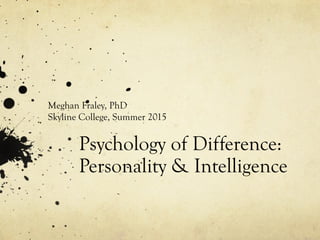This document provides an overview of concepts related to personality and intelligence from a psychology perspective. It discusses key topics such as:
- Definitions of personality, identity, and the self across the lifespan.
- Major theories of personality including psychodynamic, trait, humanistic, and social-cognitive approaches. Specific theorists discussed include Erikson, Freud, Maslow, and Rogers.
- Methods of measuring personality including interviews, behavioral observation, objective tests like the MMPI, and projective tests like the Rorschach.
- Major dimensions of personality identified by trait theorists like Eysenck and the Big Five model.















































